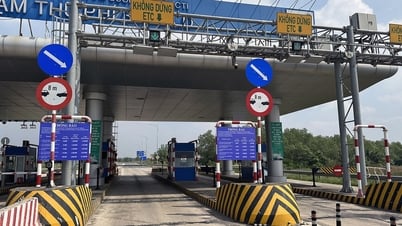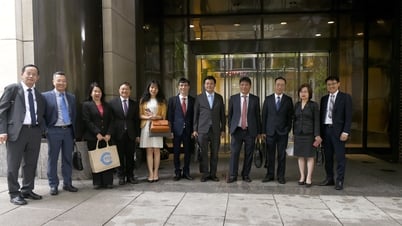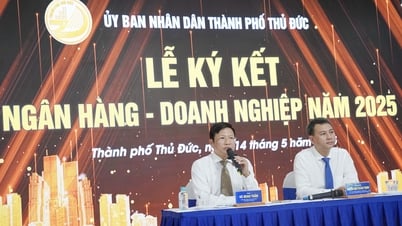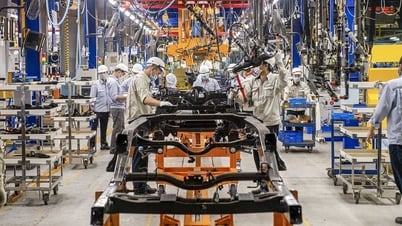How do you evaluate the development of the private economic sector today?
Mr. Dau Anh Tuan: Vietnam currently has about 940,000 enterprises and 5 million individual business households. This sector contributes 51% of GDP, creates 40 million jobs - accounting for 82% of the country's workforce, contributes 30% of budget revenue and 60% of social investment capital.

Despite their important role, private enterprises still face many limitations such as small scale, low productivity, lack of linkages and difficulties in accessing capital, land and human resources. These challenges not only affect the ability to expand but also reduce the competitiveness of the private economic sector in the context of increasingly deep integration.
According to you, what barriers are businesses facing and how does it affect the private economy?
Mr. Dau Anh Tuan: There are currently eight main barriers that are hindering the development of the private economic sector.
First, high informality and low labor productivity make it difficult for businesses to expand and improve operational efficiency. Second, weak governance and lack of professionalism are also major challenges; Third, connectivity to the supply chain is limited; Fourth, the linkage between private enterprises, the FDI sector and the global market is not yet truly sustainable; Fifth, the supporting industry is not yet strongly developed, making it difficult for domestic enterprises to participate deeply in the international supply chain.
Sixth, problems with access to capital, land and human resources remain major barriers. Seventh, private enterprises also face many difficulties in taking advantage of free trade agreements (FTAs) due to a lack of appropriate support.
Finally, in the context of the rapidly developing digital economy, current regulations are still not really suitable, causing disadvantages for domestic enterprises when participating in the digital market.
In the near future, many major policies on economic development will be issued, focusing on science, technology and private enterprises. Can these changes remove the above barriers, sir?
Mr. Dau Anh Tuan: Important resolutions such as Resolution 57, 193 and policies supporting private enterprises will help improve national competitiveness.
In particular, Resolution No. 57-NQ/TW dated December 22, 2024 of the Politburo on breakthroughs in science, technology, innovation and national digital transformation has highlighted the strategic role of science, technology and innovation. Currently, there are four most important changes in Resolution 57: Shifting from public investment to a market mechanism, encouraging enterprises to lead innovation. Second, increasing private investment in R&D, attracting capital from venture capital funds and public-private partnerships. Third, prioritizing high technology, core technology such as artificial intelligence, biotechnology, helping Vietnam become self-reliant in important areas. Fourth, developing a creative startup ecosystem, creating favorable conditions in terms of institutions, finance and markets.
Previously, science and technology were often considered as a tool to support economic development, but Resolution 57 has elevated it to a key driving force, emphasizing the central role in economic growth and national competitiveness. At the same time, the market and enterprise orientation are at the center. Shifting from an administrative model of science and technology management to a market mechanism, encouraging enterprises to lead innovation instead of relying solely on public investment.
The shift from a heavily administrative to a market-oriented science and technology management model is a breakthrough change, helping Vietnam accelerate the innovation process and enhance national competitiveness.
After Resolution 57, Resolution 193 (piloting a number of special mechanisms and policies to create breakthroughs in science, technology, innovation, and national digital transformation) of the National Assembly created an important step forward in accepting risks in scientific and technological research. Previously, research projects were often bound by the principle of capital preservation, but now there is a mechanism to accept losses in the early stages, similar to the way venture capital funds operate.
Another important change is the commercialization of research products. Previously, state-funded research was kept within the framework of state agencies, which was open, but perhaps not enough. Scientists can open businesses to bring products to market, helping to shorten the time to transfer technology.
At the same time, the tax incentive mechanism helps businesses count research grants as legal expenses, creating a stronger incentive to invest in R&D.
A notable highlight is the low-altitude satellite pilot, opening up opportunities for remote, border and island areas to access the internet from systems like Starlink. This is a positive signal, creating a premise for socio-economic development in these areas, especially for businesses that are investing or intending to invest in this area.
To create a breakthrough for the private economic sector, what should Vietnam do in the coming time, sir?
Mr. Dau Anh Tuan: To remove barriers and create breakthroughs for the private economic sector, Vietnam implements a number of key groups of solutions as follows:
First, it is necessary to promote institutional and business environment reforms by simplifying administrative procedures, making laws transparent, and addressing overlaps in current regulations. The Government has identified 263 overlapping documents and is reviewing and adjusting them. In addition, it is necessary to have separate laws for business households and small businesses, while promoting a spirit of business support and testing policies according to the sandbox model for new business models.
Next, it is necessary to create favorable conditions for enterprises to access new sources of capital. Currently, private enterprises still depend mainly on bank loans, while the stock market is not really attractive to small and medium enterprises. Although Vietnam ranks third in Southeast Asia in terms of startup investment, it still lacks strong enough venture capital funds. Therefore, it is necessary to establish a fund to support small and medium enterprises, develop corporate bonds, build a Pre-IPO fund and a national fund for startups, and establish a separate stock exchange for small and medium enterprises to increase capital mobilization.
A separate policy for domestic private enterprises is also key. It is necessary to narrow the preferential gap between private enterprises and foreign-invested enterprises and state-owned enterprises; at the same time, apply preferential policies on corporate income tax, access to land and low-interest credit for large-scale private enterprises in key industries. In particular, it is necessary to create a "red corridor" for important private enterprises, with a commitment to legal, financial stability and long-term incentives.
To help private enterprises reach out to the global market, it is necessary to make the most of FTAs and support small businesses to participate in international fairs to build their brands. At the same time, it is necessary to strongly develop domestic distribution chains and promote government support in enhancing national brands.
Applying science and technology and developing high-quality human resources are also important factors. Enterprises need to be supported to apply artificial intelligence (AI), big data and smart manufacturing technology. Tax and capital incentives for enterprises investing in R&D and AI need to be promoted. At the same time, the training system needs to focus on STEM, technology and engineering fields, while strengthening the connection between enterprises and universities and research institutes to improve the quality of human resources.
In addition, Vietnam can learn from successful models in the world, especially South Korea and Taiwan (China). South Korea developed chaebol groups thanks to strong support in credit, export, research and development (R&D) as well as prioritizing the domestic market. Meanwhile, Taiwan (China) focused on promoting small and medium enterprises (SMEs) through flexible financial policies, supporting R&D, startups and developing industrial clusters. What both countries have in common is the proactive role of the government in selecting key industries and providing long-term support for businesses.
With these comprehensive solutions, Vietnam can create a turning point for the private business sector, helping this sector truly become a driving force for growth, innovation and integration in the new development stage.
Thank you!
Source: https://thoibaonganhang.vn/thao-vong-kim-co-de-kinh-te-tu-nhan-tao-ky-tich-tang-truong-162155.html






![[Photo] Readers line up to visit the photo exhibition and receive a special publication commemorating the 135th birthday of President Ho Chi Minh at Nhan Dan Newspaper](https://vphoto.vietnam.vn/thumb/1200x675/vietnam/resource/IMAGE/2025/5/17/85b3197fc6bd43e6a9ee4db15101005b)
![[Photo] More than 17,000 candidates participate in the 2025 SPT Competency Assessment Test of Hanoi National University of Education](https://vphoto.vietnam.vn/thumb/1200x675/vietnam/resource/IMAGE/2025/5/17/e538d9a1636c407cbb211b314e6303fd)
![[Photo] Prime Minister Pham Minh Chinh chairs meeting on science and technology development](https://vphoto.vietnam.vn/thumb/1200x675/vietnam/resource/IMAGE/2025/5/17/ae80dd74c384439789b12013c738a045)


















![[Photo] Nearly 3,000 students moved by stories about soldiers](https://vphoto.vietnam.vn/thumb/1200x675/vietnam/resource/IMAGE/2025/5/17/21da57c8241e42438b423eaa37215e0e)










































































Comment (0)